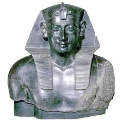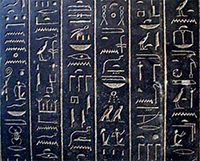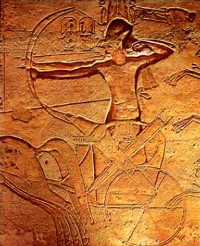A History of Ancient Egypt
Part 3: Highs and Lows
Egypt maintained more peaceful relations with its neighbors as well, encouraging trade routes to the north, south, east, and west. Goods traded included ebony, ivory, and (of course) gold. In the case of Nubia (or Kush), to the south, Egypt eventually decided that conquest was the preferred strategy. (Nubia reversed its fortunes later, during the Third Intermediate Period, and formed a dynasty of their own with which to occupy the Egyptian throne.) 
In Persia, Egypt found a foe it could not conquer. The Persian ruler Cambyses in 525 B.C. annexed Egypt into the Persian Empire. Egypt wrested itself from the Persian yoke in 404 B.C. and enjoyed a last period of independence for a few decades. The Persians returned, however in 343 B.C. and defeated Egypt again. Alexander the Great arrived in 332 B.C., conquering Persia and proclaiming himself the new ruler of Egypt. His successor in the Two Lands, Ptolemy I (left), ruled for a time, providing stability in the wake of the vacuum in the Hellenistic world created by the death of Alexander. Ptolemy encouraged development throughout the land and moved the capital from Memphis to Alexandria and commissioned great building projects, among them the Pharos Lighthouse, one of the Seven Wonders of the Ancient World; and the Great Library of Alexandria. Ptolemy founded a dynasty that ended when Roman armies under Octavian deposed the last pharaoh, Cleopatra VII in 31 B.C. Egypt became a Roman province thereafter.  The Ancient Egyptians used pictures tell stories and to relate facts and figures. The Egyptians regarded these characters as sacred, the creation of Thoth, god of knowledge. The name for these pictures was hieroglyphs (from the Greek hiero, meaning "holy," and glypho, meaning "writing." These hieroglyphs date to the earliest years of Egyptian civilization. The legacy of Ancient Egypt lives on in the Great Pyramid, which still stands, and the Great Sphinx, which still stands, and the Nile River, who still flows (and overflows). The story of Egypt has been told in pictures on pillars and temple walls and scrolls and grave goods, found in tombs of all sizes and several shapes. First page > Beginnings and Basics > Page 1, 2, 3
|
|
Social Studies for Kids
copyright 2002–2025
David White



 Egypt vied with neighboring civilizations for supremacy in the ancient Middle East many times throughout the 3,000 years before Rome took over. It was not uncommon for Egyptian armies to fight against the the
Egypt vied with neighboring civilizations for supremacy in the ancient Middle East many times throughout the 3,000 years before Rome took over. It was not uncommon for Egyptian armies to fight against the the 
